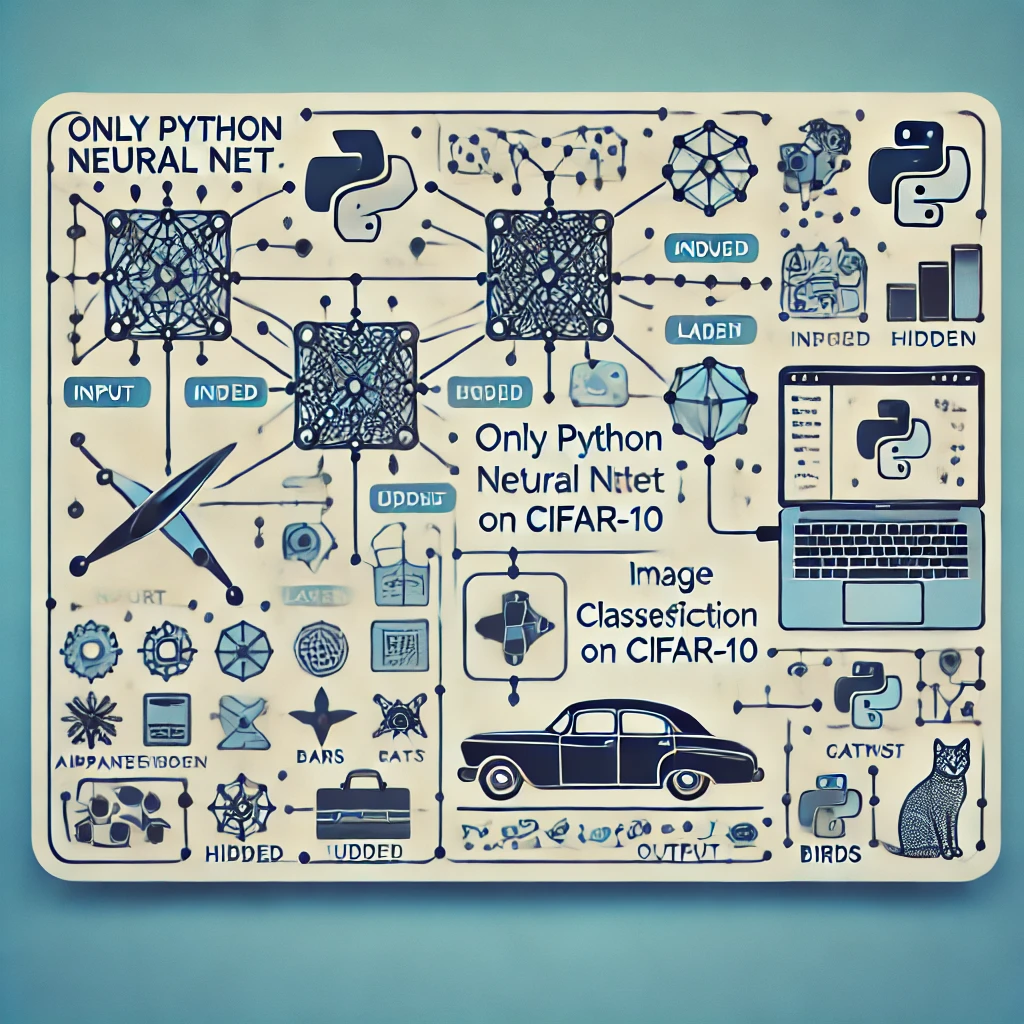
In this blog article, we will study the process of image classification using a neural network on the CIFAR-10 dataset. The CIFAR-10 dataset consists of 60,000 32×32 color images in 10 different classes. We will go through the entire process, from loading and preprocessing the data to building, training, and evaluating a neural network.
Sections
- Introduction to Image Classification and CIFAR-10
- Loading and Preprocessing the Data
- Building the Neural Network
- Training the Neural Network
- Evaluating the Model
- Improvements and Next Steps
1. Introduction to Image Classification and CIFAR-10
Image Classification: Image classification is a process where we categorize images into predefined classes. For example, classifying an image as a cat, dog, airplane, etc.
CIFAR-10 Dataset: The CIFAR-10 dataset is a collection of images used for training machine learning and computer vision algorithms. It has 60,000 images divided into 10 classes (e.g., airplane, automobile, bird, cat, etc.). Each image is 32×32 pixels and is in color.
2. Loading and Preprocessing the Data
Before we can use the CIFAR-10 dataset, we need to load and preprocess it. The preprocessing steps include normalizing the image data and splitting it into training and testing sets.
Data Loading
We will use a helper function to load the CIFAR-10 data from a binary file. Here’s how we can implement the data loading function:
import numpy as np
import pickle
def unpickle(file):
with open(file, 'rb') as fo:
dict = pickle.load(fo, encoding='bytes')
return dict
def load_cifar10():
# Implement CIFAR-10 data loading here
# For brevity, we'll assume the data is loaded into X_train, y_train, X_test, y_test
# X_train shape: (50000, 3072), y_train shape: (50000,)
# X_test shape: (10000, 3072), y_test shape: (10000,)
pass
Data Preprocessing
We normalize the pixel values to be between 0 and 1 by dividing by 255.
# Normalize the data
X_train = X_train / 255.0
X_test = X_test / 255.0
3. Building the Neural Network
We will build a simple feedforward neural network with one hidden layer. This network will consist of an input layer, a hidden layer with ReLU activation, and an output layer with Softmax activation.
Neural Network Class
Here’s the complete implementation of the neural network:
class NeuralNetwork:
def __init__(self, input_size, hidden_size, output_size):
self.input_size = input_size
self.hidden_size = hidden_size
self.output_size = output_size
# Initialize weights and biases
self.W1 = np.random.randn(self.input_size, self.hidden_size) / np.sqrt(self.input_size)
self.b1 = np.zeros((1, self.hidden_size))
self.W2 = np.random.randn(self.hidden_size, self.output_size) / np.sqrt(self.hidden_size)
self.b2 = np.zeros((1, self.output_size))
def forward(self, X):
# Forward pass
self.z1 = np.dot(X, self.W1) + self.b1
self.a1 = self.relu(self.z1)
self.z2 = np.dot(self.a1, self.W2) + self.b2
self.a2 = self.softmax(self.z2)
return self.a2
def backward(self, X, y, output, learning_rate):
# Backward pass
one_hot_y = self.one_hot_encode(y)
dz2 = output - one_hot_y
dW2 = np.dot(self.a1.T, dz2)
db2 = np.sum(dz2, axis=0, keepdims=True)
dz1 = np.dot(dz2, self.W2.T) * self.relu_derivative(self.z1)
dW1 = np.dot(X.T, dz1)
db1 = np.sum(dz1, axis=0)
# Update parameters
self.W2 -= learning_rate * dW2
self.b2 -= learning_rate * db2
self.W1 -= learning_rate * dW1
self.b1 -= learning_rate * db1
def train(self, X, y, epochs, batch_size, learning_rate):
for epoch in range(epochs):
for i in range(0, X.shape[0], batch_size):
X_batch = X[i:i+batch_size]
y_batch = y[i:i+batch_size]
output = self.forward(X_batch)
self.backward(X_batch, y_batch, output, learning_rate)
if epoch % 10 == 0:
loss = self.calculate_loss(X, y)
print(f"Epoch {epoch}, Loss: {loss}")
def predict(self, X):
output = self.forward(X)
return np.argmax(output, axis=1)
def calculate_loss(self, X, y):
output = self.forward(X)
one_hot_y = self.one_hot_encode(y)
return -np.sum(one_hot_y * np.log(output + 1e-8)) / X.shape[0]
@staticmethod
def relu(x):
return np.maximum(0, x)
@staticmethod
def relu_derivative(x):
return (x > 0).astype(float)
@staticmethod
def softmax(x):
exp_x = np.exp(x - np.max(x, axis=1, keepdims=True))
return exp_x / np.sum(exp_x, axis=1, keepdims=True)
@staticmethod
def one_hot_encode(y):
one_hot = np.zeros((y.size, 10))
one_hot[np.arange(y.size), y] = 1
return one_hot
4. Training the Neural Network
The training process involves feeding the training data through the network, computing the loss, and updating the weights using backpropagation.
if __name__ == "__main__":
# Load and preprocess data
X_train, y_train, X_test, y_test = load_cifar10()
# Normalize the data
X_train = X_train / 255.0
X_test = X_test / 255.0
# Initialize and train the model
input_size = 3072 # 32 * 32 * 3
hidden_size = 128
output_size = 10
model = NeuralNetwork(input_size, hidden_size, output_size)
model.train(X_train, y_train, epochs=100, batch_size=32, learning_rate=0.01)
5. Evaluating the Model
After training the model, we evaluate its performance on both the training and testing sets by calculating the accuracy.
# Evaluate the model
train_predictions = model.predict(X_train)
test_predictions = model.predict(X_test)
train_accuracy = np.mean(train_predictions == y_train)
test_accuracy = np.mean(test_predictions == y_test)
print(f"Train Accuracy: {train_accuracy}")
print(f"Test Accuracy: {test_accuracy}")
6. Improvements and Next Steps
To improve this basic neural network, consider the following:
- Adding More Layers: Increase the network’s depth by adding more hidden layers.
- Regularization: Apply techniques like L1/L2 regularization or dropout to prevent overfitting.
- Data Augmentation: Enhance the training data by applying transformations like rotation, flipping, and cropping.
- Learning Rate Schedulers: Adjust the learning rate during training for better convergence.
- Advanced Architectures: Explore more complex architectures like Convolutional Neural Networks (CNNs), which are particularly effective for image data.
This guide has walked you through the process of building, training, and evaluating a neural network for image classification on the CIFAR-10 dataset. By following these steps and considering potential improvements, you can develop more sophisticated models and achieve better performance in your image classification tasks.

